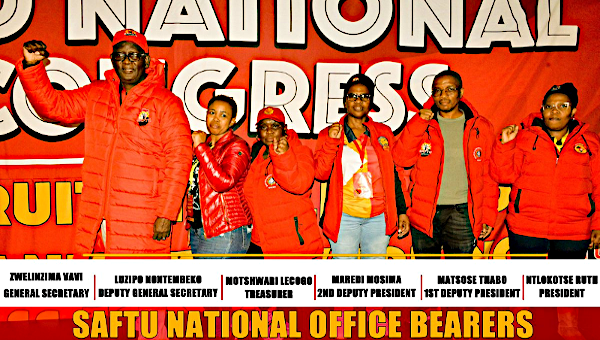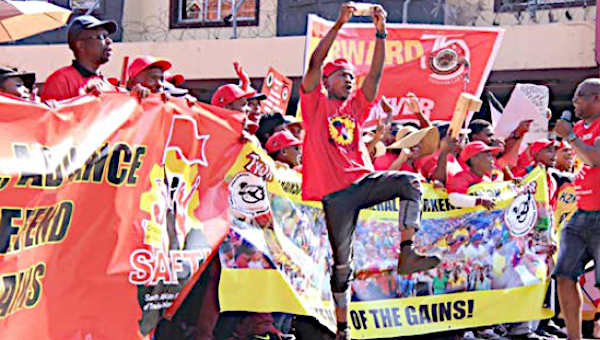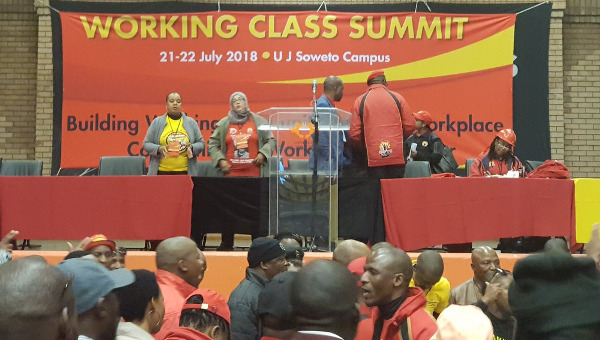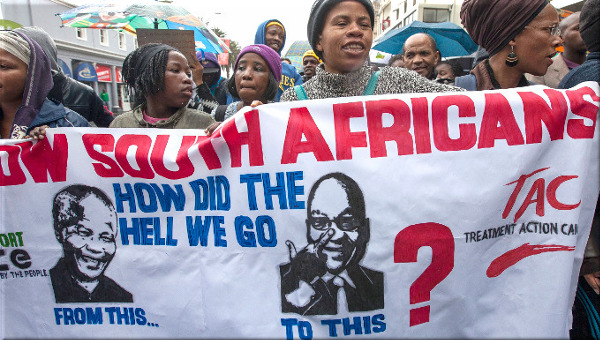There is a passage from Olive Schreiner’s 1883 novel The Story of An African Farm where she describes the isolated existence of the rural Karoo, with its “weird and almost oppressive beauty…the stone walled sheep kraals and kaffer huts.” This cursory and derogatory description of farm worker’s dwellings is perhaps the only time they feature in the book. Rather, labourers and their homes are considered part of the farm’s natural landscape and as such are rendered invisible and silent social actors. In present day South Africa the lives of farm workers, and the dangerous and oppressive working conditions they face, remain invisible to most. The only time they provoke public debate, or indeed any political action by the ruling African National Congress (ANC) and the opposition Democratic Alliance (DA) is in moments of extreme tragedy.
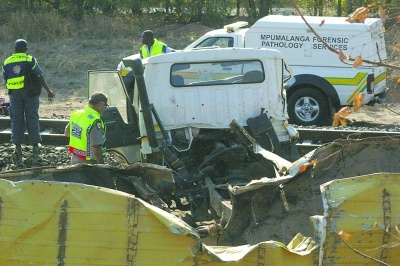
The recent collision between a truck carrying farm workers and coal train in Mpumalanga is illustrative of this fact. Twenty-five workers were killed when the truck taking them to harvest oranges on a nearby citrus farm collided with a train and was dragged 200 meters down the track. The workers were transported on the back of an open truck, which as anyone who has spent time in rural South Africa knows is the most common means of transport for workers to and from the farms. Known as the bakkie brigade, this mode of transportation is a ubiquitous feature in rural areas during the harvesting season when many farmers employ labour brokers to source cheap labour from nearby localities, often informal settlements comprised of former farm workers. The South African Food and Allied Worker’s Union (FAWU) alleges that the truck was owned by a labour broker, which raises crucial questions of culpability between the broker, farm owner and driver in the transport of these workers. Many of these questions remain unresolved in South Africa’s labour legislation, which remains structured around a normative standard employment relation despite rapid increases in informal and third party employment.
Increase in Casual and Temporary Workers
The transportation of farm workers over long distances is but one example of the changing nature of rural labour relations and the restructuring of capital accumulation in agriculture. In South Africa the introduction of legislation protecting farm workers after 1994 alongside tenure rights for farm dwellers has caused many commercial farmers to restructure their operations, relying increasingly on casual and temporary workers in order to avoid compliance with labour laws. The historic reliance of on-farm permanent workers to perform the bulk of agricultural labour is gradually being eroded as casuals, many of who are foreign migrants and women, work for a few months each year in the fields and pack houses. These changes have also been driven by post-apartheid economic reforms, including the deregulation of agricultural markets and adherence to WTO trade policies, which have consolidated ownership in the hands of fewer commercial farmers and exposed them to global markets. This is the context in which the Mpumalanga accident must be understood. Sadly, it is one that threatens to be repeated as agricultural production continues to rely on cheap and flexible labour trucked in under unsafe conditions by unscrupulous labour brokers.
While historically different, neoliberal trade and labour market policies in North America have also caused Canadian farmers to change their labour recruitment strategies. Canada’s Seasonal Agricultural Workers Program, for example, imports farm labour from Mexico, Central America and the Caribbean to meet the demands of local farmers. Here the intermediary of the triangular employment relation is not the broker, but rather the state which sets the terms and conditions of the contract. Migrant workers are placed on farms for 3-8 months after which they must return home hoping to be rehired the following year. According to Justicia for Migrant Workers (J4MW), a migrant worker solidarity group based in Canada, “Migrant workers perform rigorous and often dangerous rural labour that few Canadians choose to do. Many workers are reluctant to stand up for their rights since employers find it easier to send workers home (at their own expense) instead of dealing with their serious concerns.” On top of low wages, no benefits, and no legal right to unionize, these workers face the constant threat of deportation if they speak out against their employer. It is within this context that we must understand the crash that six months ago killed 11 farm workers, including 9 migrants from Peru, near the Canadian town of Waterloo. Since the accident there has been no government investigation into the transportation and living conditions of migrant farm workers in Canada and fleeting media coverage. Like South Africa, migrant farm workers in Canada live in isolated rural areas, often housed directly on the farms, where they often experience severe discrimination and racism.
Disposable Workforce?
Both of these accidents are the inevitable outcome of a system of production that treats farm workers as a cheap and ultimately disposable workforce. In North America the ravages of NAFTA on the Mexican economy and the structural adjustment of the Jamaican economy by the World Bank in the 1980s were acutely felt by the country’s poor and working-classes. As a result of these policies, Canadian agrarian capital can rely on a steady stream of cheap migrant labour from the South. In its role as intermediary, the Canadian state will continue to prevent these workers from settling permanently in the country or gaining any organizing rights. This is not to suggest that Canadian workers are somehow immune from enforced labour flexibility. Indeed, there are clear trends toward increasingly precarious forms of work among domestic workers. Migrant workers however, are neoliberalism’s ideal workforce: shipped in to perform specific tasks without draining state resources and sent home when no longer needed.
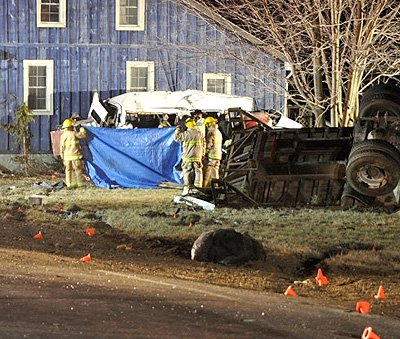
In the South African case, the surplus labour force of mostly unskilled workers was historically absorbed into mining and agriculture, but steep job losses in both of these sectors has meant escalating unemployment, which now stands at around 40 per cent (70% of whom are between the ages of 17-25). South Africa embarked on a high-skill growth path after 1994, which largely neglected the needs of poor and rural workers without access to education or training. Jobs that have been created for low and semi-skilled workers have tended to be low-paid and temporary. Rather than addressing the needs of these workers the ANC has pursued a limited deracialization strategy through Affirmative action measures, the most important being known as Black Economic Empowerment (BEE) which, as economists Jeremy Seekings and Nicoli Nattrass argue has benefitted full-time unionized workers while neglecting the needs of the unemployed – their conclusions however, that the selfish preferences of unions are to blame for low job growth, is highly questionable. This historically disadvantaged ‘underclass,’ as they call them, is without access to land capital or educational opportunities and forms the bulk of temporary and casual farm labour.
One of the most salient features of the new global division of labour is this increasing divide between a core of permanent employees, still protected by corporatist arrangements, and a fragmented and unorganized majority of informal and precarious workers. The Canadian state is furthering these divisions with changes to the Temporary Foreign Worker Program that will allow employers to pay migrant workers 15 per cent less than the local minimum wage. The move has rightly been branded as a brazen attempt at dividing workers along national and racial lines and at creating a sub-category of more vulnerable and unprotected workers. Back in South Africa these same tensions are at play over a proposed government youth wage subsidy, which would see the state provide subsidies to employers who hire young people. With youth unemployment being staggeringly high the subsidy has been seized upon by the right wing opposition DA to attract the unemployed and youth vote while simultaneously branding trade unions as greedy and self-interested. In reality the subsidy is nothing more than an opportunity for business to replace unionized workers with cheaper and unorganized workers. In their rejection of the subsidy, the Unemployed People’s Movement have argued that,
“Big business built its wealth on the back of a history of racist oppression that included land dispossession and the migrant labour system. The government should not be subsidizing them now. The government should be subsidizing the poor directly!”
Yet the discursive, and entirely artificial, construction of an unemployed youth pitted against greedy unionized workers is a potent weapon in times of economic uncertainty. It also fits surprisingly well with mainstream developmental rhetoric, particularly the social capital school of thought trumpeted by the World Bank, that praises the entrepreneurialism and ingenuity of the poor and informal workers as the new productive subjects of post-fordist capitalism. In reality informality and precarious forms of work are, as South African labour scholar Franco Barchiesi notes, “new avenues for accumulation,” as workers incomes as a share of the national income declined from 55 per cent in 1970 to 42 per cent in 2007 while the share of company profits rose from 28 to 32 per cent over the same period. The poor it seems are getting poorer.
A New Form of Slavery?
The main union federation COSATU has called for an outright ban on labour brokerage, labelling it a new form of slavery. Rhetoric aside, and the occasional stone throwing at DA marches, unions have done little to organize the most vulnerable workers in the economy. Farm workers in particular have the lowest unionization levels in the country and no major unions are actively organizing these workers. The call for a ban on labour brokers merely illustrates the ideological rifts apparent in the tripartite alliance rather than an effective strategy for organizing those who rely on labour brokers for their wages. The prospects for a ban seem increasingly unlikely given the fact that regulating brokers is already under discussion in parliament. As one COSATU official told me, the unions need to organize casual workers, but they just don’t know how to go about it.
One possibility is the integration of social and community struggles over service delivery, healthcare and access to land with the combined demand for decent work. This would involve a reorientation of COSATU toward civil society organizations active in poor and rural areas, the possibilities of which are a constant source of discussion and debate. The struggle over land access is a particularly important one as the precarious livelihoods of rural workers could potentially be stabilized by secure access to land for small crop production. However, the state’s ineffective approach to land reform will only change through sustained political pressure, and at present no such movement exists to pose this challenge.
Any campaign that demands decent employment for farm workers must also confront the concentrated and racialized ownership structure of South African agriculture and in doing so challenge the existing corporate food regime. As Walden Bello has argued, the turbulence that underlines the global food system – that resulted in riots and wide scale protests against the rise in food prices in 2008 – is not merely due to speculation on commodity futures and investment in biofuels but is rather a far deeper crisis of capitalist agriculture. The accidents that claimed the lives of farm workers in South Africa and Canada are markers of this crisis, which marginalizes and brutalizes those millions of farm workers who produce our food. The challenge then is not only to ensure safe transportation for farm workers, but also to challenge the global agricultural system that prioritizes profits over nature and the lives of its workers. It is a challenge to make visible the hidden world behind grocery store shelves and for the workers themselves to occupy a long neglected political space. •
This article first published by amandlapublishers.co.za.


